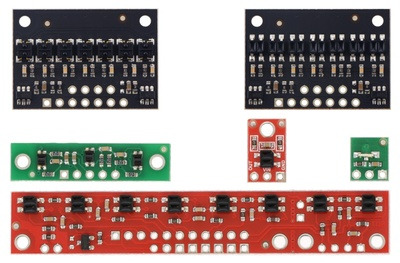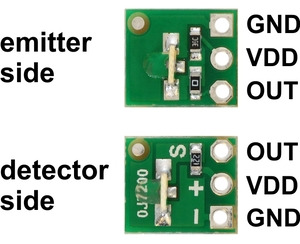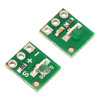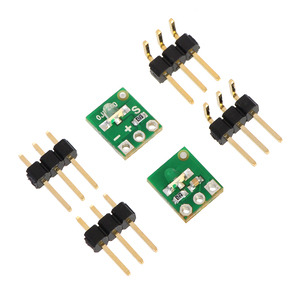Sensors » Pololu QTR Reflectance Sensors » Older QTR Sensors »
QTR-L-1A Reflectance Sensor (2-Pack)
The QTR-L-1A reflectance sensor incorporates a right-angle infrared LED and a right-angle phototransistor in an inexpensive, tiny 0.35″ × 0.3″ module that can be mounted almost anywhere and is great for edge detection and line following. The reflectance measurement is output as an analog voltage. This sensor is sold in packs of two units.
 Compare all products in Older QTR Sensors or
Compare all products in Older QTR Sensors or  Single-Channel QTR Reflectance Sensors.
Single-Channel QTR Reflectance Sensors.
| Description | Specs (1) | Pictures (5) | Resources (10) | FAQs (0) | On the blog (0) | Distributors (5) |
|---|
Note: The QTR-L-1A reflectance sensor requires an analog input to take readings. The similar QTR-L-1RC reflectance sensor is available with a digital I/O-compatible output.
Functional Description
 |
The Pololu QTR-L-1A reflectance sensor carries a right-angle infrared LED and a right-angle phototransistor, both pointing toward the front edge of the board. The phototransistor is connected to a pull-up resistor to form a voltage divider that produces an analog voltage output between 0 V and VIN (which is typically 5 V) as a function of the reflected IR. Lower output voltage is an indication of greater reflection.
The LED current-limiting resistor is set to deliver approximately 17 mA to the LED when VIN is 5 V. The current requirement can be met by some microcontroller I/O lines, allowing the sensor to be powered up and down through an I/O line to conserve power.
This sensor was designed to be used with the board perpendicular to the surface being sensed, and narrow-angle lenses built into the infrared LED and phototransistor packages allow it to be effective to a range of about 1″ (25 mm). Because of its small size, multiple units can easily be arranged to fit various applications such as line sensing and proximity/edge detection. The QTR-L-1A is sold in packs of two units.
For a similar sensor that can be used with the board parallel to the surface, but with shorter range, please see the QTR-1A reflectance sensor. We also offer arrays of three and eight sensors: the QTR-3A reflectance sensor array and the QTR-8A reflectance sensor array.
 |
QTR sensor size comparison. Top row: QTRX-HD-07, QTR-HD-07; middle row: QTR-3, QTR-1, QTR-L-1; bottom row: QTR-8. |
|---|
Specifications
 |
- Dimensions: 0.3″ × 0.35″ × 0.12″ (without optional header pins installed)
- Operating voltage: 5.0 V
- Supply current: 17 mA
- Output format: analog voltage
- Output voltage range: 0 to supplied voltage (dependent on operating environment)
- Optimal sensing distance: 0.125″ to 0.25″ (3 mm to 6 mm)
- Maximum recommended sensing distance: 1″ (25 mm)
- Weight without header pins: 0.006 oz (0.2 g)
Interfacing with the QTR-L-1A Output
There are several ways you can interface with the QTR-L-1A output:
- Use a microcontroller’s analog-to-digital converter (ADC) to measure the voltage.
- Use a comparator with an adjustable threshold to convert the analog voltage into a digital (i.e. black/white) signal that can be read by the digital input line of a microcontroller.
- Connect the output directly to the digital input line of a microcontroller and rely upon its internal comparator.
This last method will work if you are able to get high reflectance from your white surface (so that there is a large output voltage difference over black and white surfaces), but will probably fail if you have a lower-reflectance signal profile. The following table shows some typical output voltages from the sensor over different surfaces and at different distances:
| White surface | 3/4″ black electrical tape | |
|---|---|---|
| 0.25″ distance | 0.2 V | 3.8 V |
| 1″ distance | 2.4 V | 3.5 V |
Ambient light, especially sunlight, can affect the sensor readings significantly. If the output voltage from the QTR-L-1A is consistently low, you might need to add shielding around the sensor or mount it in a different location to reduce interference from outside light sources.
Our Pololu AVR library provides functions that make it easy to use these sensors with our Orangutan robot controllers; please see the QTR Reflectance Sensors section of our library command reference for more information. We also have a Arduino library for these sensors.
Included Components
Each pack of two reflectance sensors includes sets of straight male header strips and right-angle male header strips, which allow you to mount them in the orientation of your choice. You can also solder wires, such as ribbon cable, directly to the pads for the most compact installation.
|
|
People often buy this product together with:
 |
QTR-8A Reflectance Sensor Array |
 |
QTR-L-1RC Reflectance Sensor (2-Pack) |
 |
QTR-1A Reflectance Sensor (2-Pack) |





















